
The game I decided to play was “inbento”, a cute puzzle game about being in a cat family and making bentos. It’s developed and published by Afterburn, and is available on various platforms including the Nintendo Switch and Steam. Very cute and family-friendly, the game seems to be targeted to all ages as it is overall simple in structure, though the puzzles themselves do offer challenge for perhaps older players. The game is single-player and as noted, simple in overall structure – like many puzzle games, you have a menu with various levels, and the goal is to solve them all. You can’t really “fail” a game like this, as levels are simply solved/unsolved and the only outcome that completes the game is to solve them.
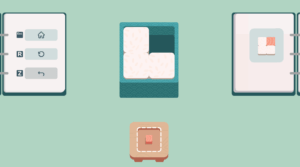
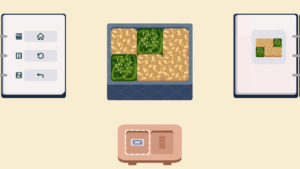
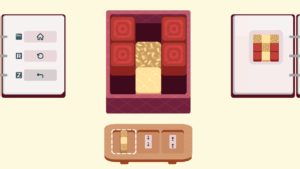
(Example of bento box puzzles in increasing difficulties as levels advanced)
I found the onboarding of the game particularly well-made. It introduces new mechanics such as placing bento food squares, rotating their positions, some being locked, rotational directions, and increasingly wacky but understandable ones. Learning the new mechanic first in a puzzle is pretty intuitive and easy, and the challenges ramp up as they start to combine them or use bigger boxes. In general, I found that “inbento” had a very nice difficulty curve and the harder puzzles were typically challenging but not too frustrating.
This made solving some of the more difficult puzzles feel quite satisfying! Additionally, while the game is one person vs. the game, it was fun to play it with friends, as sometimes they would see a pattern I hadn’t at first. Sometimes neither of us had the full solution just yet, but noticing our respective pieces/method, the answer would click. In addition to the puzzles, “inbento” does have some narrative, revolving around the mother cat raising her child kitten. The premise is that you’re making bento boxes for your kitten to eat every day as they get older. I loved this concept and thought the mechanics did well in conveying it, as the concept and puzzles matched the narrative – the purpose of solving the puzzles as making bento boxes for the child kitten made sense and gave a motivating but lighthearted feel. The boxes growing more complex and larger as the kitten grows thus was also fitting and provided a nice narrative backdrop to the puzzles.
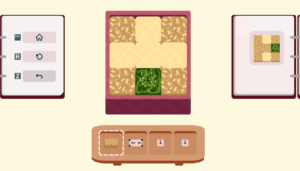
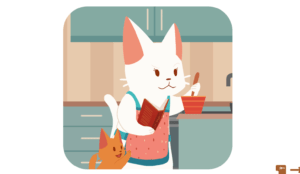
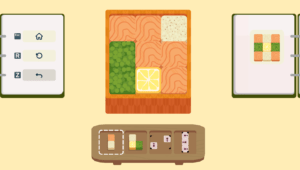
(More challenging, satisfying puzzles we solved! Also example of narrative image given after solving a set)
As a side note, my friend and I did have a “bruh” moment when solving one puzzle. It was a new chapter after we had been playing for a while already, but an early level and pretty simple puzzle. We confused ourselves trying to figure out how to swap the corner pieces with limited actions, not realizing we could just swap the middle ones. Eventually, we recognized this and solved the puzzle, but it definitely felt like a “we’re dumb” moment than a “difficult puzzle” one. Aside from our own blunder, I thought perhaps it was in part due to how long we had been playing and had already at that point experienced difficult puzzles, causing overthinking and a bit of brain burnout. In general, we enjoyed the interspersed narrative, but felt like it was very very short and would’ve loved more of it, even text. Especially to break up the monotony of doing a bento box, and moving onto the next, with only a few narrative images to change up the pace.
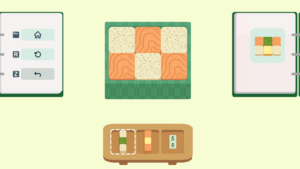
(Simpler puzzle we took longer than probably necessary to solve, deeper in the game)
Other things I thought could improve the game included a few tweaks, such as a visual indicator of the more complicated movements. It could get a little tricky to visualize what certain motions were doing without just doing it, and while there was a useful undo button, it would help feel like I was trying a solid strategy. Otherwise, it would feel like I was just randomly shuffling food squares around, or I’d sit there staring and not moving pieces to get an idea of the bigger picture first. The other major suggestion would be, as mentioned, injecting more narrative, as I really liked the set-up and thought focusing on it more would really take “inbento” to the next level.
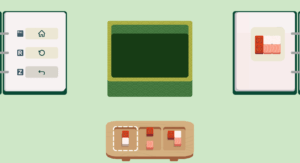
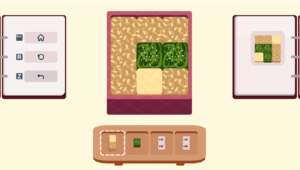
(More in-game examples of how the puzzling process looks like)
Hence, I thought “inbento” succeeded in conveying the fun of “Challenge” but could improve upon its goal of conveying Narrative. As I solved more puzzles, I found that the game was great at helping one be more flexible in one’s thinking, as focusing too hard on a certain goal could make you miss other arrangements. Overall, I thought “inbento” was a well-designed, cute, fun, and casual puzzle game, with simple but carefully selected mechanics and attention to the weaving together of puzzling and setting.


